We don’t think we could have possibly made fuelling optimal endurance performances any easier than this.
Summary
- Fuel Optimal Performances
- Consume the Correct Amount of Carbohydrate
- Balance Your Fuelling & Hydration Requirements
- Fuel According to Your Needs
- Enjoy a Huge Variety of Textures & Flavours
Why Fuel?
Before you learn about the TORQ Fuelling System, it’s vital that you understand why it is so important to fuel properly in the first place. You don’t have to read all the text within this tab – you’ll learn everything you need to know by watching either one of the 5-minute videos below. Never has the concept of fuelling endurance performances been so thoughtfully explained. Once you’ve watched the video, feel free to read on to gain a deeper understanding of the fuelling concept.
This video features a cyclist, but regardless of your endurance discipline, the principles of fuelling remain the same. The Fuelling Running tab offers some solid running-specific guidance, yet all the information in the tabs on this page are relevant to all endurance disciplines and will help you to personalise your own hydration and fuelling strategy whatever it is you do.

Quite simply, you can’t store enough carbohydrate to sustain high intensity endurance exercise indefinitely. At a strong focussed pace, your stored carbohydrate (glycogen) reserves will be used up in less than 90 minutes and when you’ve burned your last gram of carbohydrate, your pace will drop off dramatically – this is called ‘Bonking’ in cycling or ‘Hitting the wall’ in running. If you’ve not consumed a carbohydrate-rich diet in the lead up to exercising, you will bonk/hit the wall even sooner. At a slower pace, your glycogen stores will last longer, so pace management is a good way to preserve your onboard glycogen, but this will mean that you’re not going to be travelling very fast!
If you fuel with carbohydrate whilst exercising, every gram of carbohydrate you consume represents a gram of carbohydrate you won’t be burning from your stores, so it means that for any given pace, you will bonk/hit the wall later. It therefore stands to reason that the more carbohydrate you can take on board and process per hour, the longer you will last. Also, as more carbohydrate is burnt at higher exercise intensities, another way of looking at the benefits of fuelling during exercise is that it will allow you to maintain a higher pace for longer and the more carbohydrate per hour you can absorb and use, the more pronounced this will be.
In order to fully understand the benefits of fuelling, firstly, it’s important to understand the differences between ‘Endogenous’ and ‘Exogenous’ carbohydrate:
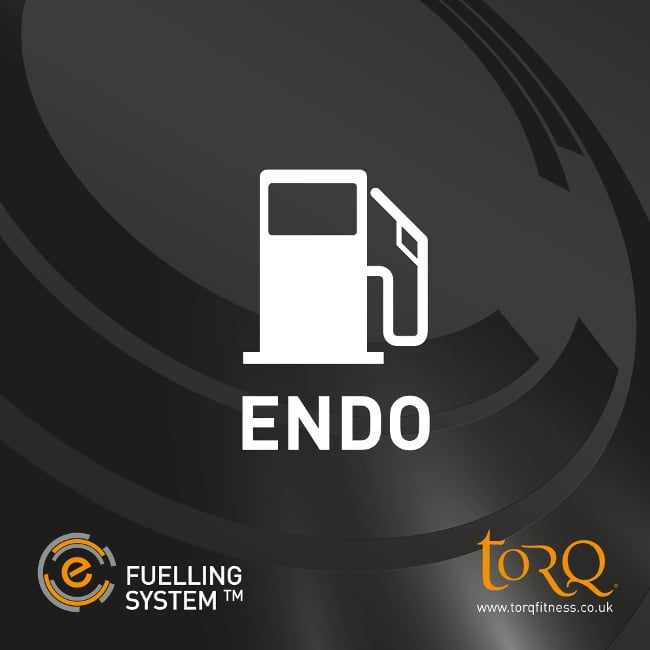
Endogenous (ENDO) refers to carbohydrate that is stored in your liver and muscles – called ‘Glycogen’. Even on a diet rich in carbohydrate, the most you can expect to store is around 500g or 2,000 kCals (and that’s if you’re a well trained athlete – the less conditioned you are, the less you can store). When your stores are full, they’re full, so high carbohydrate consumption in the hours approaching exercise will have no effect on your stores if they’re already saturated. As an example to clarify this point, it would be like leaving the tap running on the bath – once the water level reaches the overflow, the bath will get no fuller however much water you keep pouring in. This is a vital concept to understand and it’s where many people go wrong when it comes to fuelling for optimal performance. One final and very important point to note about endogenous carbohydrate stores is that when they run out, your metabolism will grind to a halt and your pace will drop off dramatically or you may even collapse. ‘Bonking’ or ‘Hitting the wall’ is not a pleasant experience and it really is ‘game over’ as far as a meaningful physical performance is concerned.
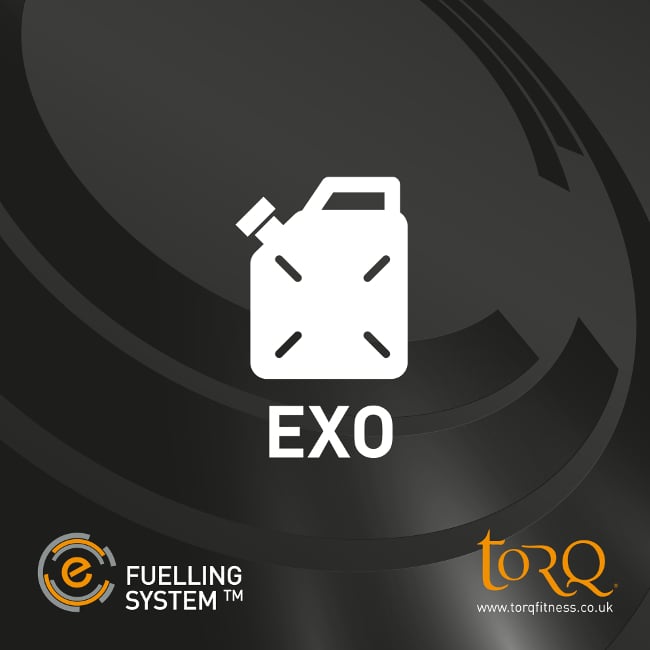
Exogenous (EXO) refers to carbohydrate consumed during exercise and with regard to TORQ products, this would be in the form of TORQ Energy Drink, TORQ Gel, TORQ Bar and TORQ Jellies. Any carbohydrate consumed during exercise, even if it’s a banana or jelly babies, are still considered exogenous carbohydrate – they may not be optimal, but they are forms of exogenous carbohydrate. This carbohydrate enters the blood stream and is burnt preferentially over your endogenous stores, but it is the speed that these carbohydrate sources get into your bloodstream that is critical to performance, which is why optimised products like TORQ exist. Exogenous carbohydrate isn’t stored, it’s used straight away and the more you can get into your blood, the less of your stored carbohydrate you need to use. It’s important to note that for high intensity endurance activities, it’s impossible to supply sufficient exogenous carbohydrate to halt the depletion of your endogenous stores, all it will do is slow down the regression.

Play the short clip above. This demonstrates how a cyclist relying entirely on endogenous stored carbohydrate quickly drains his/her stores and becomes fully glycogen depleted after 1 hour and 20 minutes. Note that the exogenous needle doesn’t move at all, because the cyclist isn’t consuming anything whilst exercising. All of these animated clips assume a very high intensity effort (the effort is exactly the same in each example) and you may have to play each one a few times to reach a clear understanding of what’s going on. An endurance athlete’s maximal sustainable intensity is called ‘Anaerobic Threshold’ and that’s the pace that we have assumed for the purposes of these examples.

In the clip above, we demonstrate how every time 30g of carbohydrate is consumed (1 TORQ Unit), the use of this exogenous carbohydrate slows down the burn rate of the endogenous stores, the overall benefit being, the maintenance of pace/performance for a longer time period. In this example, the cyclist lasts another 10 minutes as a result of low level fuelling. Although 1 TORQ Unit per hour certainly isn’t optimal, it’s certainly better than ZERO carbohydrate per hour.

The clip above demonstrates how consuming 60g of carbohydrate per hour extends time to exhaustion further still through the greater preservation of endogenous stores.

And finally, if you play the clip above, notice how much longer the cyclist can sustain his/her performance when consuming 90g of exogenous carbohydrate per hour, which is only possible if all the carbohydrate consumed consists of 2:1 Glucose-Derivatives:Fructose.

The clip above summarises the 4 different strategies of 0g, 30g, 60g and 90g exogenous carbohydrate consumption per hour and hopefully this makes our message crystal clear. What should also be clear from all these examples is that you should NOT delay in taking on board exogenous carbohydrate – you start consuming from the moment you start exercising, because that’s the only way you’re going to optimise the preservation of your endogenous stores. Additionally, although we have simplified our message in these animations by indicating that the rider takes his/her carbohydrate in discrete 30g units, obviously in reality, you’re not going to consume 500ml of energy drink (30g of carbohydrate) in 1 swift ingestion – any drink consumed will be ‘smoothed’ over the hour. Rest assured – as long as you consume 2-3 TORQ Units per hour in a systematic manner, you will be fuelling properly.
Incidentally, just in case you’re wondering, if we were to run a series of animations showing what happens during lower intensity endurance exercise, the results would be exactly the same in relative terms. All of the cyclists would last longer than if they were exercising at Anaerobic Threshold, because the endogenous burn-rate would be reduced, but the same principles would apply – the greater the exogenous fuel intake, the longer the cyclist would last.

In our final clip above, we pull all of these principles together and demonstrate how fuelling ‘affords’ a higher pace over a given time. In order for the athlete consuming 0g of carbohydrate per hour to be able to sustain a consistent pace for a 2 hour effort, his/her pace needs to be moderated downwards to avoid bottoming-out his/her endogenous stores and bonking – this means riding slower. On the other hand, the athlete on 90g of carbohydrate per hour can afford to push on at a far stronger pace, cover a larger distance and still finish with fuel in the tank. In this example, the well fuelled rider covers 10 more miles over the same time frame and still has 25 to 30% of his/her endogenous stores remaining at the end of the effort. The fact that the endogenous stores are less damaged despite a higher intensity effort is actually fundamental to understanding the principles of the TORQ Recovery System. If you fuel diligently, you will not only have performed better and created a bigger training stimulus, you will also have kick-started the recovery process. More on the TORQ Recovery System if you click HERE.
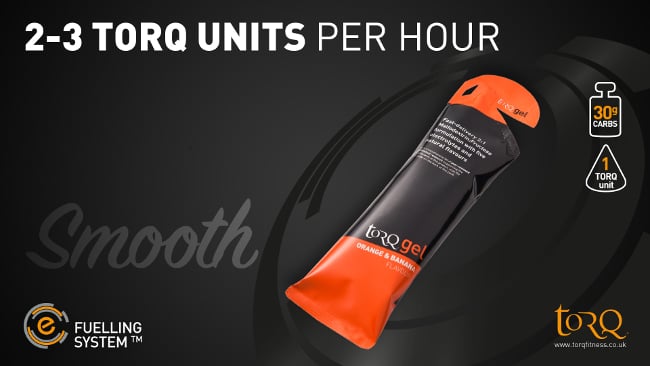
The TORQ Fuelling System doesn’t just simplify the fuelling process, it optimises it by ensuring that you consume the optimal amount for the best performances. All carbohydrate formulations are NOT equal, so please read the next tab to learn about why TORQ’s multiple-transportable carbohydrate blend enables greater carbohydrate absorption than any other recipe in existence. If you take a look at the final tab, you will find a significant number of independent peer-reviewed published studies supporting our formulations and this information has been essential in establishing the TORQ range and the TORQ Fuelling System.
System Introduction
Irrespective of your endurance discipline, whether you’re a cyclist, runner, triathlete or adventure racer, the TORQ Fuelling System will work for you. Disciplines like cycling allow you to carry a wide variety of nutrition with you, whereas running can be a little more restrictive. Read on to learn how the TORQ Fuelling System works and if you’re a runner, or your sport incorporates running, take a look at the Fuelling Running tab a little further along and consider which approach and mix of TORQ fuelling products will work best for you.
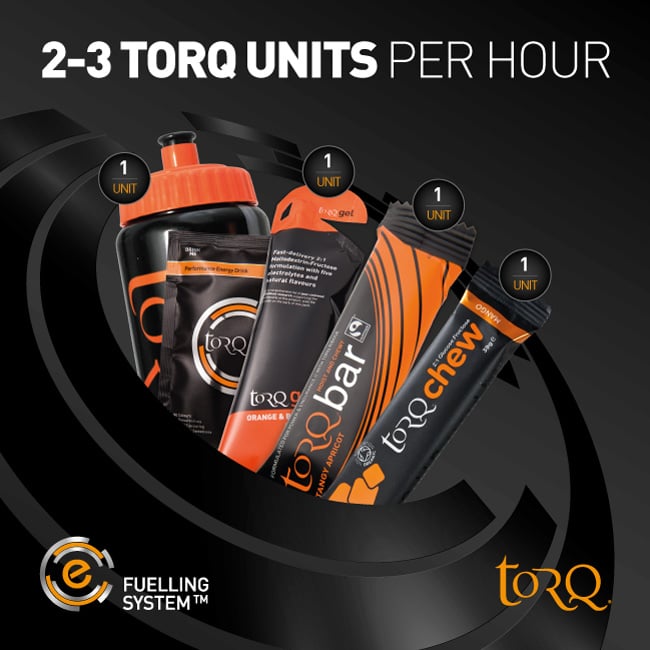
Our guidelines are simple. For optimal endurance performances, take 2-3 TORQ units per hour. 1 TORQ unit equals 30g of multiple-transportable carbohydrate and we have made consuming your TORQ units extremely easy by creating uniformity across our product range.
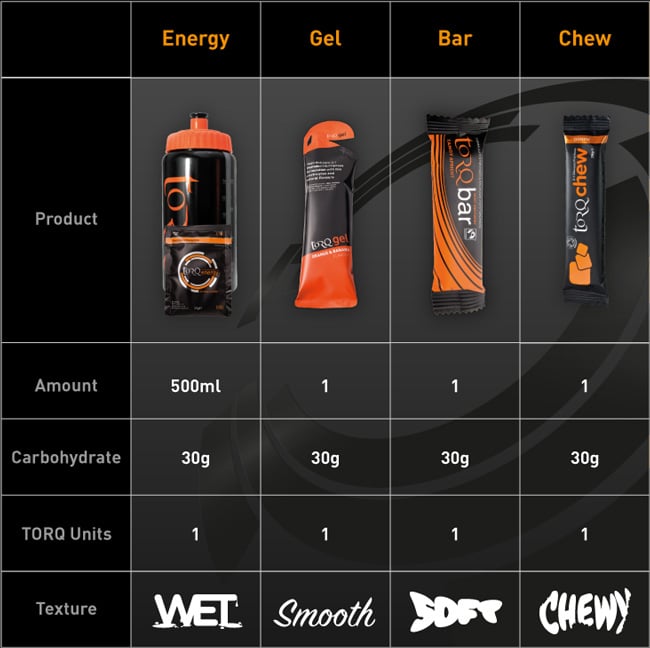
If the weather is hot and/or perspiration rates are high, it makes sense to consume more 500ml TORQ Energy drink units, because you’ll be simultaneously taking on board both fluid and electrolytes with your carbohydrate to facilitate hydration.
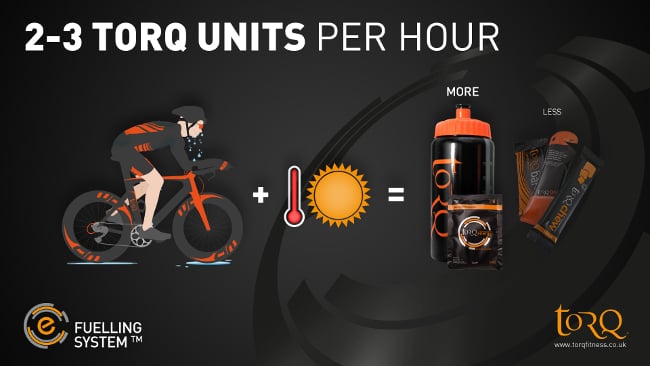
In cooler weather, overconsumption of TORQ Energy will fill your bladder and your exercise will be interrupted by toilet stops! This is where drinking less, but gaining your TORQ units through the more concentrated TORQ fuel sources (Gels, Bars and Jellies) makes more sense.
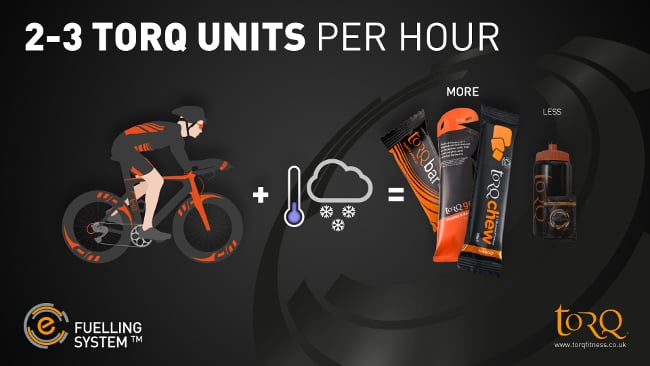
Essentially, irrespective of perspiration rates, your fuelling requirements remain constant, but the more you sweat, the greater the need to replace fluid and vital electrolytes. This why the TORQ Fuelling System works so beautifully, adapting to your hydration needs whilst providing the constant supply of fuel essential for optimal endurance performances. In all of the examples displayed on this page, we have used a cyclist for consistency, but whether you’re a runner, open water swimmer or triathlete, the fuelling principles remain the same.
If you haven’t watched the video headlining this page, please take the time to watch either one of the short animations below, because it covers all the TORQ Fuelling System essentials in just over 2 minutes.
If you’re a cyclist, watch this video:

If you’re a runner, watch this video (please note that TORQ Hypotonic has been renamed TORQ Hydration since this animation was produced – they are the same product):

So effectively, your carbohydrate intake should always be 60-90 grams per hour (2-3 TORQ units per hour), irrespective of the weather conditions and perspiration rates, but the method by which you choose to fuel yourself will vary. We’re recommending that newcomers and smaller individuals begin with a strategy of 2 TORQ units per hour and experiment with 3 TORQ units per hour as they become more comfortable with a structured fuelling regimen. Individuals over 65kg in weight and experienced sports people should be able to move onto 3 TORQ units per hour fairly easily and without any cause for concern, but we would always advise fuelling at 60 grams per hour (2 TORQ units) if in any doubt.
The TORQ Fuelling System essentially provides the tools to experiment with different fuelling textures and as long as you stick to the 2-3 TORQ units per hour rule and listen to your thirst reflex, there really isn’t anything that can go wrong. From a texture perspective, the TORQ Fuelling System also provides the perfect variety with fuelling products ranging from ‘Wet’ to ‘Smooth’ to ‘Soft’ to ‘Chewy’ – TORQ Energy, TORQ Gel, TORQ Bar and TORQ Jellies respectively. The choice of texture is all yours.
The infographic below sums up the simplicity of the TORQ Fuelling System perfectly:

Easy As 1 2 3
Whilst we recommend 2-3 TORQ Units per hour to fuel optimal endurance performances, does this mean that you can’t use TORQ products if you don’t take your sport quite so seriously? Of course not. If you’re new to the ‘fuelling game’ or you’re looking for a nutritional product that can simply assist you on your endurance journey, TORQ will not only make this very easy for you, but there are some significant benefits you’ll get from using our Fuelling System products to help you achieve this.
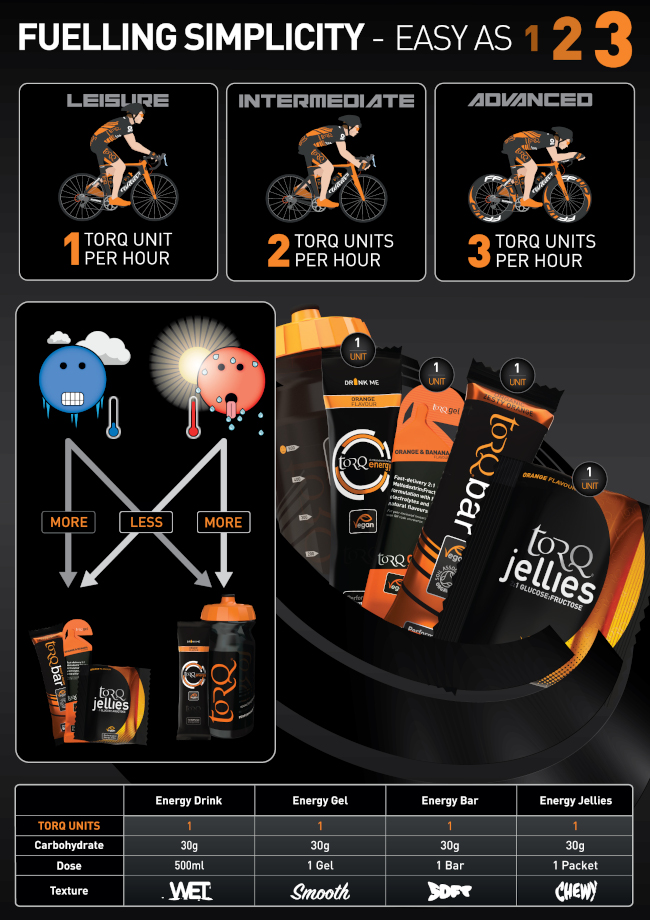
Our EASY AS 1 2 3 concept helps to explain in greater detail how the TORQ Fuelling System can deliver differing hourly doses of carbohydrate depending on what you want to achieve from your exercise sessions.
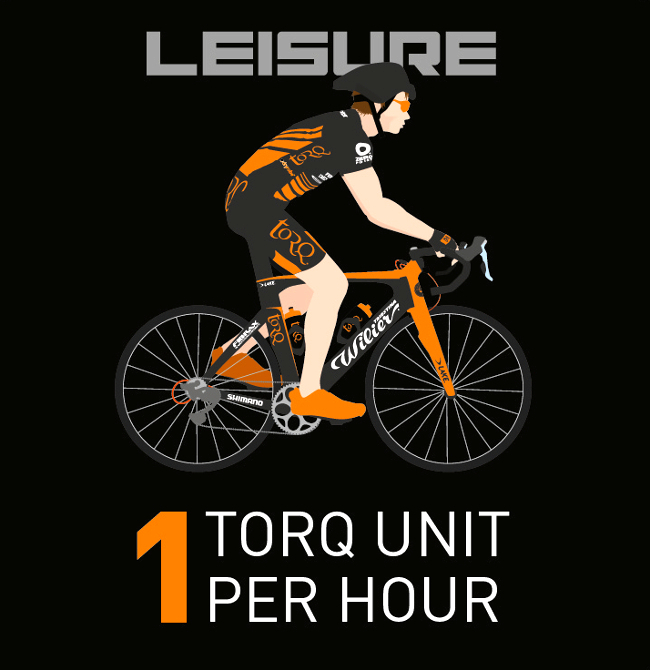
1. If you’ve never really used energy and hydration products in a structured way before, start with just 1 TORQ Unit per hour. If you watch the comprehensive ‘Why Should I Fuel?’ video a couple of tabs over, we explain how there are performance benefits to be gained from consuming as little as 30 grams of carbohydrate (1 TORQ Unit) per hour. The message is that some carbohydrate is better than no carbohydrate!
If for instance you’re out for a trail run or mountain bike ride with friends at a relaxed and sociable pace, but you plan on being out for a prolonged period of time, regularly consuming a small dose of carbohydrate will help you to enjoy the experience and you won’t feel so drained after you’ve finished.
If you do choose to try 1 TORQ Unit per hour and find that you run out of energy towards the end of your exercise session, consider moving up to 2 TORQ Units per hour on the following occasion and see if this fixes the problem. You don’t just have to be a novice to consider consuming 1 TORQ Unit per hour either. You could be a serious athlete, but the exercise session you have planned is so low in intensity that either you require a much lower level of fuelling that you would if the intensity were to be higher.
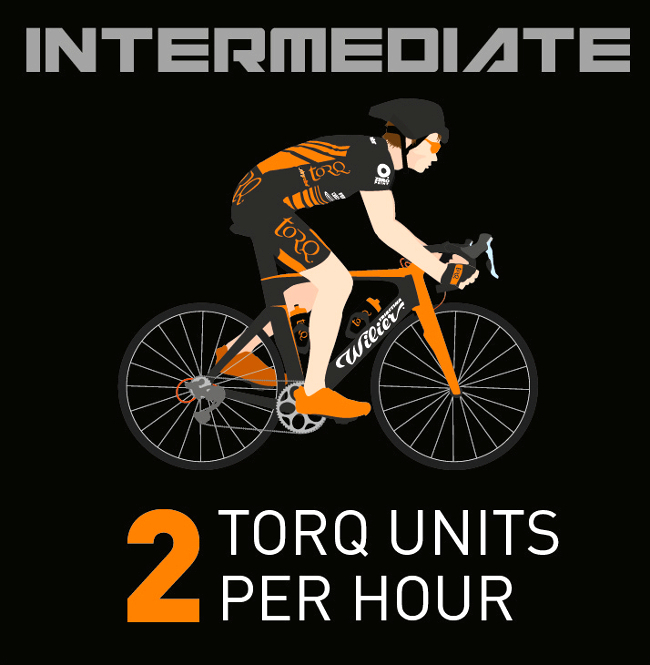
2. If you’ve used energy products before and really want to notice a difference in your endurance performance, sticking diligently to 2 TORQ Units per hour will deliver some noticeable results. Again, our ‘Why Should I Fuel?’ video a couple of tabs over illustrates how 2 TORQ Units per hour is beneficial over 1. Most energy products max-out at 60 grams of carbohydrate per hour because they use a single glucose energy source whereas TORQ is ticking over at just over 60% of its potential, which means that 2 TORQ Units per hour is absorbed quickly into the body and sits very easily on the stomach. 2 TORQ Units per hour is a comfortable and effective level of fuelling and represents our default position here at TORQ.
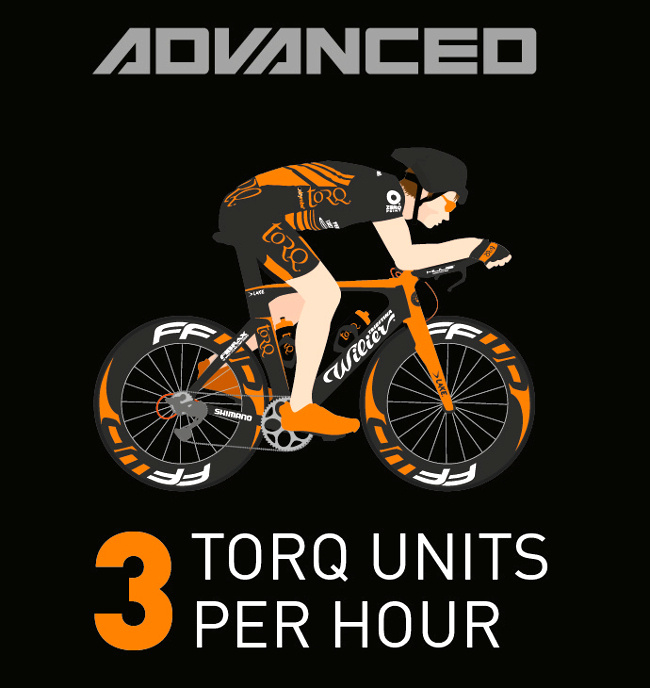
3. Consuming 90 grams of carbohydrate per hour is optimal. 3 TORQ Units (90g carbohydrate) per hour is a unique offering by TORQ, because if it wasn’t for our meticulously consistent approach to product formulation across our drinks, gels, bars and chews, this level of functional carbohydrate delivery just wouldn’t be possible. It’s at 3 TORQ Units per hour where the TORQ Fuelling System starts to deliver optimal performances. In the same way that a highly tuned sports car has to burn more fuel to deliver the performance the driver needs, if you want the best performances, the more fuel you can deliver to your muscles, the faster and further you will go.
If you’ve been training for that all important event or race, get your body used to using 3 TORQ Units per hour and reap the benefits. Again, take a look at the ‘Why Should I Fuel?’ video a couple of tabs over to understand the performance benefits 3 TORQ Units per hour brings.
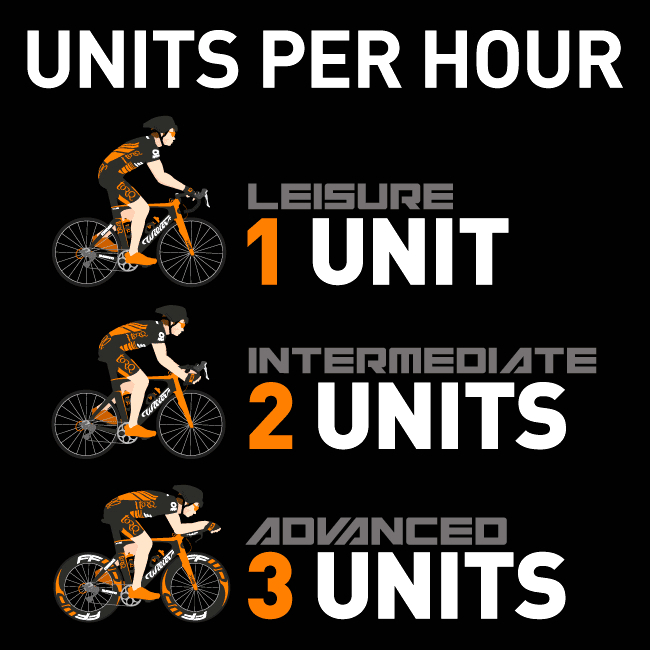
Hydration
It would be easy to assume from its name that the TORQ Fuelling System considers only fuelling and does not pay attention to hydration. If you have got this far and read the tabs prior to this one, you will understand that this simply isn’t the case. The unique way in which the TORQ Fuelling System has been constructed means that in higher perspiration environments, calories or TORQ Units are ‘drunk’ rather than ‘eaten’ thus simultaneously addressing fuelling and hydration needs. There are however additional hydration benefits that are realised when carbohydrate and water are consumed together, which we explain in detail here. Consuming fluid without carbohydrate is called Passive Transport and with carbohydrate is called Facilitated Transport:
Passive Transport: Here, water moves across the small intestine as a result of an osmotic gradient, which is a result of a pressure difference between the solution in the small intestine and blood stream. Water molecules move across semi permeable membranes (the intestinal wall) through channels called aquaporins. The animation below demonstrates the passive transport process:

Facilitated Transport: Water can also enter the body in the small intestine as a result of the absorption of carbohydrate and sodium, through the process of cotransport. Carbohydrates, such as glucose, are absorbed into the body via a specific transporter called sodium-glucose cotransporter 1, or SGLUT1 for short. These transporters act as a conveyor belt for glucose and sodium, moving them across the small intestine without the need for an osmotic gradient. As carbohydrate and sodium is moved through the SGLUT1 transporter, it also drags with it large volumes of fluid, significantly assisting in hydration. For every single glucose molecule (and 2 sodium molecules) that is moved by SGLUT1, 260 water molecules are moved with it (Loo, Zeuthen, Chandy, & Wright, 1996). The animation below demonstrates the facilitated transport process working in conjunction with passive transport:

Both TORQ Energy Drink and TORQ Hydration Drink can be used as part of the TORQ Fuelling System and both benefit from both passive and facilitated transport processes. To learn more about the functional differences between these two drinks, read our article: What’s The Difference? article.
Over-consumption
For most people, there is little point in exceeding 3 TORQ units per hour from a performance perspective, because they won’t be able to use the extra fuel anyway and over-consumption will cause undesirable gastric discomfort. 90g per hour has long been considered the human body’s absorption threshold for 2:1 Glucose-Derivatives:Fructose, so taking more carbohydrate on board than this is likely to cause problems.
However, more recently researchers have been looking at carbohydrate intakes of 120g per hour (4 TORQ Units per hour) and 2:1 formulations have been proven by Virbay and colleagues (2020) in real-world settings to be both tolerable and to provide performance benefits by reducing markers of muscle damage. Whether there is any carbohydrate-sparing (fuelling) benefit is too early to call. Researchers have looked at various ratios of Glucose-Derivatives:Fructose (2:1, 1:0.8 and 1:1) and it is unclear whether fuelling benefits are actually derived from such high consumptions as this may cause a down-regulation in fat metabolism. It is certainly in vogue for coaches to be advising professional endurance athletes to train their digestive systems to take onboard 120g of multiple-transportable carbohydrates per hour. If you are interested in this area of research and would like to experiment with 4 TORQ Units per hour, please take the time to read the following articles:
Training Your Digestive System
Understanding Glucose:Fructose Ratios
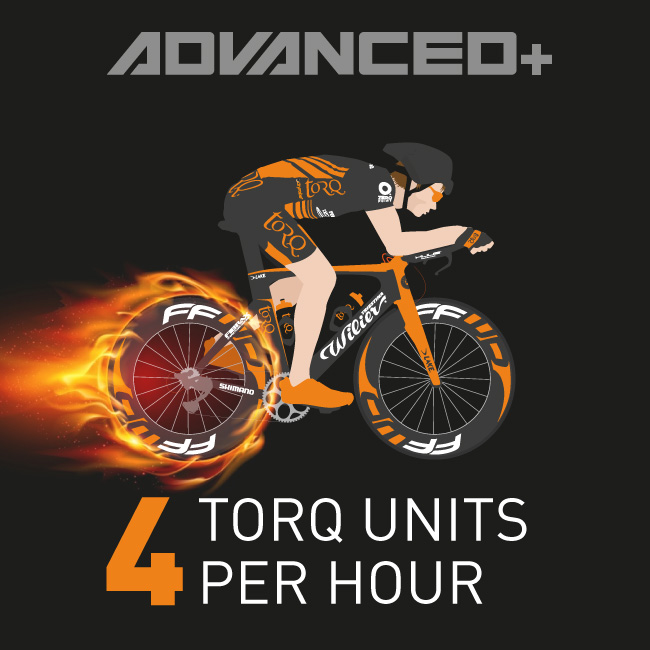
The great benefit of TORQ’s multiple-transportable carbohydrate (2:1 Glucose-Derivatives:Fructose) matrix is that it is so rapidly digested and absorbed compared to other formulations that don’t fit this ratio. This enables the human body to handle larger quantities of carbohydrate than more traditional glucose-only formulations would allow. The science and rationale behind this 40% higher absorption rate for 2:1 formulations is explained in detail under the Why 2:1? tab a little further on, so please take the time to read this section.
Glucose-only formulations (including maltodextrin-only recipes) have a proven absorption threshold of around 60g per hour. This means that trying to consume the 90g per hour of these formulations is simply beyond the human body’s digestive capacity and is bound to cause gastric distress. From a ‘stomach comfort’ perspective, let’s look at this another way. If you were to have a choice of consuming the equivalent of 2 TORQ Units or 60g of carbohydrate per hour through 2 different formulations, would you rather use a formulation that is at its digestion absorption threshold at 60g per hour or one that is 30g below it’s absorption capacity at 60g of carbohydrate per hour? Of course, you’d be far better off consuming 60g of a formulation that has the capacity to deliver 90g.
To summarise, the benefits of 2:1 Glucose-Derivatives:Fructose formulations are 2-fold:
1: A greater absorption ceiling at 90g per hour +, so more fuel can be delivered, resulting in better performances.
2: Taking on less than 90g per hour is exceptionally light on the stomach compared with glucose-only formulations, so much less likely to cause gastro-intestinal distress.
If you are experiencing stomach problems whilst exercising and fuelling, there could be a number of other reasons for this and you may find the following article useful:
If this doesn’t help, please don’t hesitate in contacting us at enquiries@torqfitness.co.uk or phone 0344 332 0852.
Why 2:1?
Why are TORQ’s multiple-transportable carbohydrate (2:1 Glucose-Derivatives:Fructose) formulations so much more effective than those produced using a traditional single carbohydrate source?
Carbohydrate is the critical fuel source during intense exercise and is essential during bouts of endurance training and competition. The more carbohydrate that is oxidised (burnt) the better your performance, as demonstrated by a mountain of peer reviewed independent research studies. The body has a very limited endogenous supply of carbohydrate, stored in the muscles and liver, and when fully topped up, it equates to around 2000kcal (500grams of carbohydrate). This is a relatively limited pool of carbohydrate and during high intensity exercise it can be completely depleted in as little as an hour. This combined with a limited capacity to absorb carbohydrate into the blood stream in the intestine means that as an endurance athlete competing or training for more than a couple of hours, you are essentially fighting a losing battle. No matter how well you are able to fuel with carbohydrate, you will eventually run out, particularly when performing endurance exercise longer than a couple of hours in duration. As a result, the more carbohydrate that can be absorbed during exercise, the greater the oxidation rate (burning) of exogenous carbohydrate, which reduces the reliance on the body’s endogenous stores. This results in a performance improvement by delaying the dreaded ‘bonk’ and subsequent catastrophic drop in performance!
For a number of years the maximum oxidation rate of exogenous carbohydrate was thought to be around 1gram of carbohydrate per minute (60grams of carbohydrate per hour) when using a single form of carbohydrate, such as maltodextrin or glucose. This was limited by the speed at which a single form of carbohydrate could be absorbed by the body. Once the intestinal transporter that absorbs the carbohydrate from the intestine (SGLT1), driving it into the blood becomes saturated, any additional carbohydrate simply ends up sat on the stomach, which is the last thing you want when exercising, since this can result in gastrointestinal upset. However more recently a growing body of research has suggested greater oxidation rates of carbohydrate are possible if glucose derivatives and fructose are mixed. The animation below shows how transportation of glucose derivatives from intestine to blood (via SGLT1) is limited to 60grams per hour. Play the short video below a couple of times over to fully understand the concept.

A study by Wallis et al. in 2005 turned conventional wisdom on its head and sparked a change in the recommendations for fuelling during endurance exercise. Wallis and his research group showed that by combining maltodextrin (glucose) with fructose at a 2:1 ratio, carbohydrate oxidation rates increased by a massive 40% and allowed up to 90grams of carbohydrate to be absorbed into the system! This was due to fructose and maltodextrin using different intestinal transporters (Fructose uses the GLUT5 transporter), which meant that the two carbohydrates could be absorbed independently of each other, allowing a faster absorption and a higher oxidation rate of carbohydrate. The study had massive implications as a 40% increase in exogenous carbohydrate oxidisation would naturally have a big impact on performance by reducing reliance on the body’s limited endogenous stores. Since the study by Wallis et al (2005) there has been a great deal of further research into the use of multiple transportable carbohydrates (i.e. maltodextrin and fructose) and a number of significant benefits to using this formulation have come to light. The animation below demonstrates how the GLUT5 transporter draws fructose through the intestinal wall independently of glucose absorption, resulting in the delivery of a significant 90grams total carbohydrate per hour. Once again, play the video below a couple of times to fully understand the concept.

Currell and Jeukendrup (2008) completed one of the first studies which looked directly at the effect of a glucose:fructose, 2:1 beverage on performance. Using a simulated 1-hour time trial in the lab, after 120 minutes of cycling exercise at 55% of their VO2max (maximal oxygen consumption), participants consumed either a placebo (flavoured water), glucose or a glucose:fructose drink. The results of the study were simply astounding. Performance improved by 8% as a result of using the 2:1 glucose:fructose drink, which was on top of a 10% improvement in performance from taking on glucose alone! Similarly Triplett et al. 2010 also showed an 8.1% performance improvement due to a higher power output when using glucose:fructose drink during a simulated 100km cycling time trial. Interestingly Triplett did not measure gastrointestinal upset directly, but did report that participants on the glucose:fructose experienced no problems at all whilst many of his participants in the glucose only trial reported problems with their stomachs ‘not emptying the solution’. More recently Rowlands et al. (2012) studied the use of maltodextrin:fructose in a more practical application, using a 2h 30min mountain bike race and high intensity cycling lab test. The results also showed a significant improvement in performance in both the lab and field, with one of the most interesting findings of the study being a significant reduction in gastrointestinal upset as a result of using a maltodextrin:fructose solution.
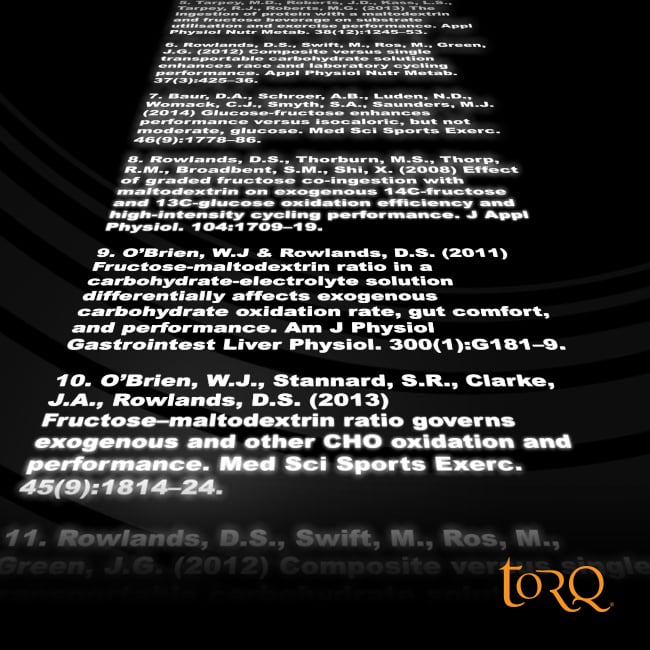
With Rowlands et al. (2012) reporting a significant reduction in GI upset as a result of using multiple transportable carbohydrates both in the lab and in the field, these findings suggest that the carbohydrate solution which participants were taking on during the study was being emptied from the stomach faster and caused less GI distress as a result of the addition of fructose. An earlier study by Jeukendrup and Moseley (2008) looked at the effect of adding fructose to glucose on gastric emptying speed during a 120min cycling bout at 61% of the participant’s VO2max. Results from the study suggested that using glucose:fructose increased the rates of gastric emptying and fluid delivery compared with glucose alone. This has quite significant practical implications as they reported faster gastric emptying would result in a faster delivery of water, aiding hydration and a reduced occurrence of stomach upset during exercise.
It is important to point out that, in order to experience the benefits of using multiple transportable carbohydrates over that of a single form of carbohydrate, you need to saturate the transporters in the intestine that absorb the carbohydrate as comprehensively as possible, so to experience the benefits, an intake of 90grams of carbohydrate per hour is recommended. Taking on board only 60 grams per hour will supply a good level of carbohydrate to the blood with an extremely low chance of any gastrointestinal discomfort, but the higher doses are where the true benefits of maltodextrin:fructose lie over single carbohydrate forms.
Further to this, a recent review by Jeukendrup (2010) has shown that carbohydrate oxidisation is not related to body weight so an intake of 90grams of carbohydrate per hour can be achievable regardless of body size. This is quite a large volume of carbohydrate and in order to achieve these sorts of intakes during competition to maximise performance, it is beneficial to practice during training. There is evidence that the gut is a trainable organ, so to ensure you can cope with the high carbohydrate intake it’s important to practice your fuelling strategy during training as this will ensure come race day you can be confident that you can take sufficient amounts on board.

A carbohydrate intake of up to 90grams per hour in the form of 2:1 Glucose-Derivatives:Fructose will aid your performance, reduce the occurrence of stomach upset, speed up the delivery of water and rapidly increase the rate at which carbohydrate can be replenished after exercise. However, it is important to point out that you will only get optimal benefits through taking in the full 90grams of carbohydrate an hour and in order to comfortably achieve this intake, it may require some practice so that the gut gets used to these high volumes. As other non Glucose-Derivatives:Fructose products will only allow 60g of carbohydrate absorption per hour, you are losing nothing by starting at this level though (2 TORQ units per hour) and the nature of the multiple-transportable carbohydrate cocktail will be very light on the stomach due to it being significantly below your absorption threshold. You literally have everything to gain from using TORQ’s formulations. We recommend that you start at 2 TORQ units per hour and train yourself up to 3.
Finally, we cover this area in more detail on our page explaining the TORQ Recovery System, but it’s appropriate to mention here how the inclusion of glucose-derivatives and fructose post-exercise is important. As an athlete undertaking repeated bouts of training or competition, the speed at which your endogenous stores of carbohydrate can be replenished after exercise can have a significant impact on your subsequent race performance or training session, so the quicker and more substantially these stores can be replenished, the better the performance in the next exercise bout. One of the major limiting factors in the restoration of these carbohydrate stores is the speed of absorption of carbohydrate (Jentjens and Jeukendrup, 2003) which is significantly increased by the use of maltodextrin:fructose.
Recent studies by Wallis et al. 2008 looked at the effect of combined glucose and fructose ingestion on short term recovery of muscle glycogen after exercise. The result of the study showed that both glucose and glucose:fructose elicited similar rates of resynthesis but, didn’t see any detriment to recovery through the use of fructose and reported resynthesis rates comparable with the highest previously reported. More recently Decombaz et al. (2011) looked at the effect of malotdextrin:fructose on liver glycogen synthesis, the body’s other major store of carbohydrate, which appears to be replenished before muscle glycogen is. The results showed a massive doubling of carbohydrate storage in the liver through the addition of fructose! This is particularly significant as a reduction in the time taken to replenish the body’s stores of carbohydrate could massively aid subsequent performance or training.
Fuelling Running
Are you a runner, or do you simply prefer the light mild flavour of our TORQ Hydration Drink over TORQ Energy Drink? If either of these questions strike a chord with you, you should read this section.
The key TORQ Fuelling System products have already been discussed:
TORQ Energy Drink
TORQ Energy Gel
TORQ Energy Bar
TORQ Energy Jellies
Each of these products represents 1 TORQ Unit or 30g of fast-delivery carbohydrate, making the maths very easy. So, is it possible to follow the TORQ Fuelling System whilst using our TORQ Hydration Drink even though it only contains 15g of carbohydrate (0.5 TORQ Units)? The answer is yes and it’s actually very easy.
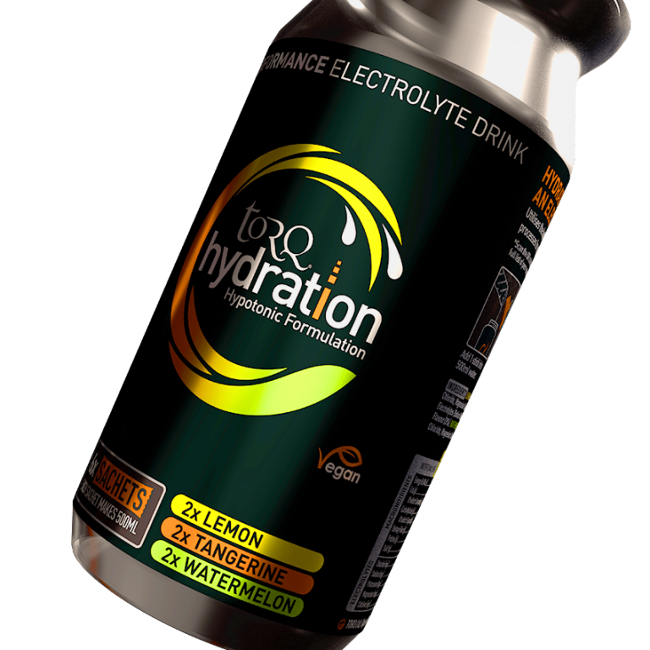
Although 500ml of TORQ Hydration represents half a TORQ Unit, it contains exactly the same amount of electrolytes as 500ml of TORQ Energy. It’s also formulated with 2:1 Glucose-Derivitives:Fructose, so is optimised for energy delivery, consistent with TORQ’s fuelling range. It can therefore be seamlessly introduced into the TORQ Fuelling System.
We accept that some of our customers may prefer the lighter flavours that TORQ Hydration has to offer over TORQ Energy and may want to simplify the TORQ Fuelling System further by effectively keeping their fuelling and hydration separate – and this is the key difference/benefit to using TORQ Hydration as part of the TORQ Fuelling System instead of our energy drink.
As TORQ Hydration has a very low carbohydrate content, it is literally impossible to over-fuel with it. In order to achieve an intake of 90g of carbohydrate per hour through TORQ Hydration alone, you would need to drink an enormous 3 litres! It would be rare to need to consume more than a litre of fluid per hour in most endurance environments and since we know that a litre of TORQ Hydration will deliver 30g of carbohydrate, a valid approach to fuelling would be to consume 2 further concentrated TORQ Units per hour (either gels bars or chews). In other words, you could set a reminder on your watch or phone to beep every 30 minutes, at which point you would consume a gel, bar or chew. Your hydration would then be a separate entity and you would simply drink to thirst with TORQ Hydration. Consuming 1 litre of TORQ Hydration along with a concentrated fuelling unit every 30 minutes would provide you with the optimal 90g of carbohydrate per hour.
If you were only to drink 500ml of TORQ Hydration in an hour, with this approach you would only take on board 75g of carbohydrate per hour, but this is still a very good level of fuelling. It would still sit within the 2-3 TORQ Units per hour range and would put you somewhere between Intermediate and Advanced on the ‘Easy as 1 2 3’ scale.
In particularly hot conditions, if you were consuming as much as 1.5 litres of fluid per hour, you could simply throttle back your concentrated fuel ingestion to 1 TORQ Unit every 45 minutes. This would give you around 70g of carbohydrate per hour, again putting you into the 2-3 TORQ Units per hour range.
With runners, we recommend adapting the TORQ Fuelling System in this way and using either TORQ Hydration or plain water in combination with a regular intake of concentrated fuelling units (usually gels), because this will allow you to take on water at feed stations during events to satisfy your hydration needs, whilst ensuring you take on board the correct amount of fuel. TORQ Hydration is available in sachet form and can be added to a 500ml bottle of water at a feed station if perspiration rates are particularly high and the need for electrolyte intake becomes significant. The video below explains this concept clearly, although please note that any references to TORQ Hypotonic refer to TORQ Hydration as we recently had a re-brand – the product is the same.

For cyclists or people taking part in other endurance sports, there’s no reason why you couldn’t adopt this system too – the great thing about the TORQ Fuelling System is that it is hugely adaptive and the products you choose to take on board to fuel and hydrate yourself can come down to preference. Just stick to the key principles and choose the products you prefer to use.
References
- Stellingwerff, T & Cox, GR. (2014)
Systematic review: Carbohydrate supplementation on exercise performance or capacity of varying durations. Appl Physiol Nutr Metab. 2014 Sep;39(9):998-1011. - Wilson. PB., Ingraham, SJ. (2015)
Glucose-fructose likely improves gastrointestinal comfort and endurance running performance relative to glucose-only. Scand J Med Sci Sports. [Epub ahead of print]. - Currell, K & Jeukendrup, A.E. (2008)
Superior endurance performance with ingestion of multiple transportable carbohydrates. Med Sci Sports Exerc. 40(2):275–81. - Triplett, D., Doyle, D., Rupp, J., Benardot, D. (2010)
An isocaloric glucose-fructose beverage’s effect on simulated 100-km cycling performance compared with a glucose-only beverage. Int J Sport Nutr Exerc Metab. 20(2):122–31 - Tarpey, M.D., Roberts, J.D., Kass, L.S., Tarpey, R.J., Roberts, M.G. (2013)
The ingestion of protein with a maltodextrin and fructose beverage on substrate utilisation and exercise performance. Appl Physiol Nutr Metab. 38(12):1245–53. - Rowlands, D.S., Swift, M., Ros, M., Green, J.G. (2012)
Composite versus single transportable carbohydrate solution enhances race and laboratory cycling performance. Appl Physiol Nutr Metab. 37(3):425–36. - Baur, D.A., Schroer, A.B., Luden, N.D., Womack, C.J., Smyth, S.A., Saunders, M.J. (2014)
Glucose-fructose enhances performance versus isocaloric, but not moderate, glucose. Med Sci Sports Exerc. 46(9):1778–86. - Rowlands, D.S., Thorburn, M.S., Thorp, R.M., Broadbent, S.M., Shi, X. (2008)
Effect of graded fructose co-ingestion with maltodextrin on exogenous 14C-fructose and 13C-glucose oxidation efficiency and high-intensity cycling performance. J Appl Physiol. 104:1709–19. - O’Brien, W.J & Rowlands, D.S. (2011)
Fructose-maltodextrin ratio in a carbohydrate-electrolyte solution differentially affects exogenous carbohydrate oxidation rate, gut comfort, and performance. Am J Physiol Gastrointest Liver Physiol. 300(1):G181–9. - O’Brien, W.J., Stannard, S.R., Clarke, J.A., Rowlands, D.S. (2013)
Fructose–maltodextrin ratio governs exogenous and other CHO oxidation and performance. Med Sci Sports Exerc. 45(9):1814–24. - Rowlands, D.S., Swift, M., Ros, M., Green, J.G. (2012)
Composite versus single transportable carbohydrate solution enhances race and laboratory cycling performance. Applied Physiology, Nutrition, and Metabolism. 37(3): 425-436. - Smith, J.W., Pascoe, D.D., Passe, D., Ruby, B.C., Stewart, L.K., Baker, L.B., et al. (2013)
Curvilinear dose-response relationship of carbohydrate (0–120 g·h−1) and performance. Med Sci Sports Exerc. 45(2):336–41. - Roberts, J.D., Tarpey, M.D., Kass, L.S., Tarpey, R.J., Roberts, M.G. (2014)
Assessing a commercially available sports drink on exogenous carbohydrate oxidation, fluid delivery and sustained exercise performance. J Int Soc Sports Nutr. 11(1):1–14. - Jentjens, R.L., Underwood, K., Achten, J., Currell, K., Mann, C.H., Jeukendrup, A.E. (2006)
Exogenous carbohydrate oxidation rates are elevated after combined ingestion of glucose and fructose during exercise in the heat. J Appl Physiol. 100(3):807–16. - Jeukendrup, A.E & Moseley, L. (2010)
Multiple transportable carbohydrates enhance gastric emptying and fluid delivery. Scand J Med Sci Sports. 20(1):112–21. - Davis, J.M., Burgess, W.A., Slentz, C.A., Bartoli, W.P. (1990)
Fluid availability of sports drinks differing in carbohydrate type and concentration. Am J Clin Nutr. 51(6):1054–7. - Jentjens, R.L., Venables, M.C., Jeukendrup, A.E. (2004)
Oxidation of exogenous glucose, sucrose, and maltose during prolonged cycling exercise. J Appl Physiol. 96(4):1285–91. - Jentjens, R.L., Achten, J., Jeukendrup, A.E. (2004)
High oxidation rates from combined carbohydrates ingested during exercise. Med Sci Sports Exerc. 36(9):1551–8. - Wallis, G.A., Rowlands, D.S., Shaw, C., Jentjens, R.L., Jeukendrup, A.E. (2005)
Oxidation of combined ingestion of maltodextrins and fructose during exercise. Med Sci Sports Exerc. 37(3):426–32. - Jentjens, R.L., Moseley, L., Waring, R.H., Harding, L.K., Jeukendrup, A.E. (2004)
Oxidation of combined ingestion of glucose and fructose during exercise. J Appl Physiol. 96(4):1277–84. - Jentjens, R.L & Jeukendrup, A.E. (2005)
High rates of exogenous carbohydrate oxidation from a mixture of glucose and fructose ingested during prolonged cycling exercise. Brit J Nutr. 93:485–92. - Fuchs, C.J., Gonzalez, J.T., Beelen, M., Cermak, N.M., Smith, F.E., Thelwall, P.E., Taylor, R., Trenell, M.I., Stevenson, E.J., van Loon, L.J. (2016)
Sucrose ingestion after exhaustive exercise accelerates liver, but not muscle glycogen repletion compared with glucose ingestion in trained athletes. J Appl Physi. [Epub ahead of print].
For reviews see…
Jeukendrup, A.E. (2010) Carbohydrate and exercise performance: the role of multiple transportable carbohydrates. Curr Opin Clin Nutr Metab Care. Jul;13(4):452-7.
Rowlands, D.S., Houltham, S., Musa-Veloso, K., Brown, F., Paulionis, L., Bailey, D. (2015) Fructose-Glucose Composite Carbohydrates and Endurance Performance: Critical Review and Future Perspectives. Sports Med. Nov;45(11):1561-76.
If you have any questions in the meantime, please don’t hesitate in contacting us on enquiries@torqfitness.co.uk or on local-rate (from landlines) 0344 332 0852






